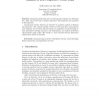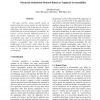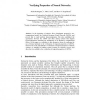IGPL
2006
14 years 7 months ago
2006
Abstract. This paper addresses the problem of establishing temporal properties of programs written in languages, such as Java, that make extensive use of the heap to allocate-and d...
FMSD
2006
14 years 7 months ago
2006
A Promela specification and a set of temporal properties are developed for a basic call service with a number of features. The properties are expressed in the logic LTL. Interactio...
SDL
2001
14 years 8 months ago
2001
Abstract. We describe an approach for the verification of quantitative temporal properties of SDL specifications, which adapts techniques developed for timed automata [2]. With res...
IEAAIE
2000
Springer
14 years 11 months ago
2000
Springer
In this paper we study how the framework of Petri nets can be extended and applied to study recurrent events. We use possibility theory to realistically model temporal properties o...
ISSTA
2010
ACM
14 years 11 months ago
2010
ACM
Real production code contains lots of knowledge—on the domain, on the architecture, and on the environment. How can we leverage this knowledge in new projects? Using a novel lig...
ACSAC
1998
IEEE
14 years 11 months ago
1998
IEEE
This paper describes various possible attacks on temporal properties such as temporal records of payment times and declarations of the closing times for electronic submissions, an...
DSVIS
2000
Springer
14 years 12 months ago
2000
Springer
This paper presents an example of how software architectures can encode temporal properties as well as the traditional structural ones. In the context of expressing concurrency con...
IWANN
2001
Springer
14 years 12 months ago
2001
Springer
In the beginning of nineties, Hava Siegelmann proposed a new computational model, the Artificial Recurrent Neural Network (ARNN), and proved that it could perform hypercomputation....
ICSE
2001
IEEE-ACM
14 years 12 months ago
2001
IEEE-ACM
Early testing of requirements can decrease the cost of removing errors in software projects. However, unless done carefully, that testing process can significantly add to the cos...
CAV
2003
Springer
15 years 22 days ago
2003
Springer
Run-time monitoring of temporal properties and assertions is used for testing and as a component of execution-based model checking techniques. Traditional run-time monitoring howev...



